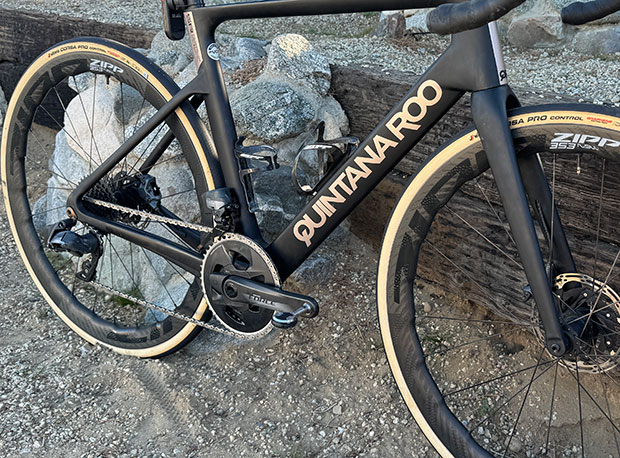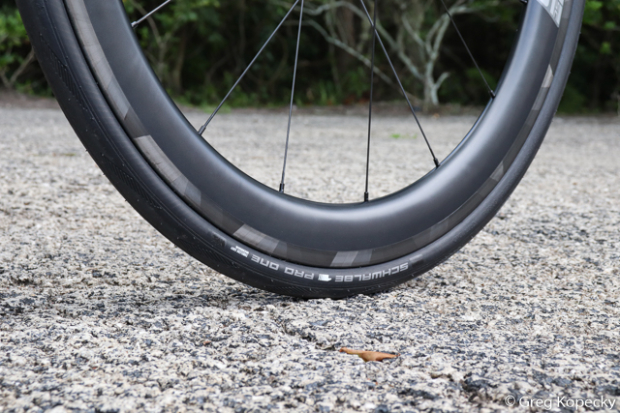Why Wider Tires Are Faster and More Comfortable

I rely a lot on BicycleRollingResistance.com. But a drum roller like the one BRR uses is only a proxy for tire speed and is limited in what it can tell you. For example, it’s a good process for sussing out who’s got the best “compound” (tread material) and who makes a good casing.
On a drum roller a 28c tire will outperform its 25c cousin every day and twice on Tuesday when the tires on the testing unit are pumped to identical pressures, but the casing on that 28c tire at that higher pressure is too stiff to be fast on the road. So you take air out of the 28c tire to normalize. Drum rollers are not just terrible, but worthless, at helping you choose your optimal tire pressure.
What are you normalizing for when you take air out of a 28c tire to reach its ideal pressure? Casing tension. You want the same casing tension in the 25c tire as the 28c tire, the 30c and 32c tire, and each wider tire needs a correspondingly lower pressure. One way to know how much to depressurize a larger tire is to use a proxy for casing tension, and one such proxy is what people call “sag” or “drop”. This is how much the tire sinks down when its rider hops aboard. Frank Berto’s data from the 1990s still holds up for high-quality, supple tires: The drop should be 15% of the measured width (assuming we’re taking really high quality, supple tires). But measuring drop is hard. Here’s the easy way to identify the right pressure: Attach yourself to an online air tire pressure calculator you trust and follow that calculator’s guidance. (More on which calculator below.)

Why a wider road tire is more comfortable
At face value it might seem that a wider tire should be no more comfortable (nor should it be faster) than a thinner tire, because the wider tire is depressurized to hit that optimal casing tension and be its “best self.” But there’s more to it. One way to look at a wider tire is to think of it as a shock absorber. The larger volume in a wider tire is like a shock with a longer stanchion. It can suck up more positive space (bumps, rocks) above the road as the tire rolls overtop, and the “preload” (remember that 15% drop?) is better able to fill negative space (holes in the road).
Why a wider road tire is faster
What makes the tire more comfortable – explained above – also makes it faster. But even on smooth roads the prevailing theory concerns the shape of the contact patch. A narrower tire has a more oval patch, longer front to back, narrower in width. The shape of that patch generates more friction than the rounder contact patch formed by the wider tire.
So, why not just make the tire really wide? For us oldster today’s road tires already are. For the last 15 years of the 20th century a 20mm tire was considered by many the fastest TT tire. The tires ridden today in road races (from 29mm to 31mm measured) and more increasingly in time trials or triathlons (29mm measured) are already 50 percent wider than they were back then and pressures, instead of being in the 120psi or 130psi range, are now often in the mid-50s psi. But the rolling resistance value of the wider tire isn’t infinite. You get a little less benefit every time you go wider. The Crr savings of a 34mm-wide tire over a 32mm tire is much less than a 28mm tire over a 26mm tire.

While Crr savings when you go wider diminish, the extra width is absolute and there is a point where the weight of the wider tire and even more so the aerodynamics of the wider tire overwhelm the rolling resistance savings. Where is that point where the aero and weight penalties forestall going wider?
What is the optimal tire width for road and TT?
What is the optimal tire size for road racing? This is a moving target for sure! One very clued-in observer, a former professional cyclist who now manages the careers of top athletes said to me last week, “Now when I look at a 28mm tire it seems skinny.” To me, the really stunning event of 2024 was Tadej Pogacar winning the Giro on a 28c tire during the road stages and then winning the Tour on what is reported to be a 30c version of that tire. I think we’re at the point where 28c is the thinnest tire that makes sense in road racing and draft-legal triathlon.
For tri and TT? A very popular combo these days in pure TT is 25c front and 28c rear. The idea is that a 28c system is faster, so use it when aero is of less importance. Use the 25c in the front. But this is easier on a TT than on a tri bike, where you probably don’t want to carry spares in 2 sizes. For tri, it is my guess that many or most of us will be riding 28c on equipment we’re buying new between now and 2 years from now.

Just, let us for a moment revisit the topic of pressures. We can’t really think of riding wider tires until we settle on a process for choosing the right pressure. I referenced the Silca calculator. The other end of the spectrum is the Rene Herse calculator which, like the Silca tire pressure calculator, is based on roll-down testing. You’ll note the Rene Herse values are quite a bit lower, as in, 10 to 15psi lower. (Rene Herse claims that Pogacar uses the Rene Herse pressure calculator values as guidance.)
How do you square the difference between 2 calculators that were constructed using the same process? I don’t know. In my own rolldown testing I come up with values more in line with Silca for these wider tires. It’s at that Silca calculator pressure my tire rolls down the hill fastest, but only by a minor amount and when I ride at those higher pressures on my local roads I get the livin’ jeebus beat out of me. So for my own riding I favor a lower pressure and in the loops I ride I’m actually faster at the lower pressure. Your best pressure might depend on how much abuse you can take; or how much vibration absorption there is in your equipment. In any case just note the for a 28c or 30c tire the optimal pressures are low, as in, the right pressure might be 75psi (that pressure in a 28c tire is makes for a hard tire!) and it might be 55psi but whatever it is it’s lower than you’re used to riding if triathlon is your activity.

How Systems Inform Ideal Tire Width
Here’s a by-product of disc brakes in road and tri bikes: You can run whatever fork blade width and shape you want, and you can do whatever you want to the rear triangle of the bike because you don’t need a rim brake caliper anywhere. This has led to bikes that have grown wider but remained aero and this even includes track bikes that have no brakes. (Did you see those wild Lotus bikes the UK team was riding on the velodrome in the Paris Olympics?) Blades, stays and wheels are all free to live their best individual aero lives. Wheels have changed as well because their designers are not burdened by rim braking surfaces. As a result the wheel/tire combo can become wider without an aero penalty (or with a very slight penalty that is more than compensated for by the faster rolling tire).
Here's what this means for TT and tri: If your bike, and your wheel, is optimized for a 25c tire your fastest tire is probably that size. If your wheel and, ideally, the bike the wheel goes into is optimized for a 28c tire then the fastest tire is 28c. If you are riding a late model Canyon Speedmax, a current model Trek Speed Concept, BMC or Cervelo P5, these bikes are either optimized for 28c or they are can at least be ridden with 28c tires with no penalty that flows from the design of the bike itself. Likewise, certain wheelsets are designed around 28c and Zipp is one obvious example.
I have never seen tire size as a driver of bike design. Until now. Whether for road, tri or gravel riders – and because of this bike designers – start with one design input that is paramount and can’t be ignored: tire size (which is tire width but also tire height, as wider tires are also taller tires). Riders choose their tire size and this allows or disqualifies the wheel; and likewise the bike that best mates with that wheel. Tires are growing wider and they’re doing so at a faster clip than I’ve ever seen. Pogacar, for his road races, appears to have graduated from 25c to 28c to 30c inside of about a year. I can’t tell you for sure where it’ll end up in 5 years. But I don’t think 28c for tri and 30c for road is a bad bet, especially when the entire bike is optimized for these tire sizes.







Start the discussion at forum.slowtwitch.com